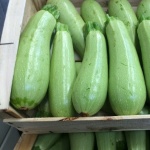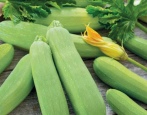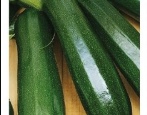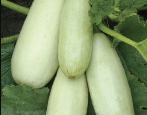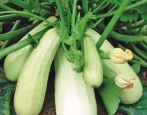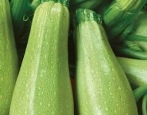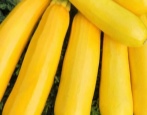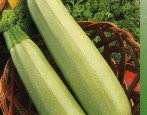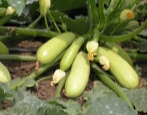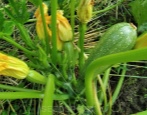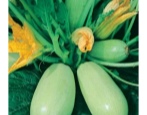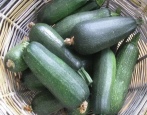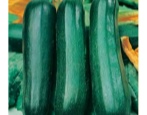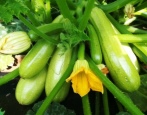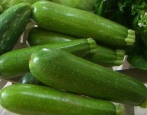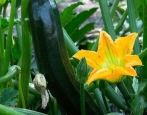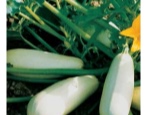
- Name synonyms: Zayach'ye ushko
- Ripening terms: early maturing
- The period from germination to harvest: 44-50 days
- Description of the plant: powerful, climbing
- Fruit shape: elongated-cylindrical
- Fruit color: greenish white
- Color of the pulp: white
- Pulp (consistency): dense, juicy
- Fruit weight, kg: up to 1.0
- Taste qualities: high
Zucchini Hare's Ear is rich in vitamins and is suitable for dietary nutrition. Dishes with its use are perfectly assimilated and have unique taste, which is why it is so in demand on the territory of our country.
Description of the variety
This is a varietal plant, which is known by another name - Zayach'ye ushko. Produces a good harvest outdoors.
The hare's ear is distinguished by its delicate pulp, but if the fruits are overgrown, then they are no longer suitable for cooking.
It is possible to plant zucchini of this variety in open ground in any region of the country, but before planting, you will need to deoxidize the soil.
Characteristics of the appearance of plants and fruits
A hare's ear grows in the form of a bush. The plant turns out to be powerful and climbing. The fruits have an elongated cylindrical shape. The length of zucchini of this variety is from 20 to 50 cm, while the weight can reach 1 kg.
Zucchini Hare's ear is greenish-white with a smooth surface. They are white inside.
Purpose and taste
The hare's ear is valued for its dense and at the same time juicy pulp. They have a high keeping quality and can be stored for up to several months. Taste characteristics are high.
The fruits are used for conservation, they are steamed, stewed, fried.
Ripening terms
This variety is classified as early maturing. Already after 44-50 days, after the appearance of the first shoots, you can pluck zucchini for food.
Yield
The hare's ear is a high-yield zucchini.
Growing regions
In any region of the country where the climate permits.
Growing and care
For planting a zucchini, the Hare's Eye should choose a sunny place where there is no draft. This variety does not like soil with high acidity and close location of groundwater. It is best to plant it according to the rules of crop rotation, that is, in the place where potatoes, onions or tomatoes grew last year.
The soil in which the Hare's Ear will grow must be well-drained and fertile. And also it is worth enriching it with compost. The pH reaction must be as close to neutral as possible.
It is worth remembering that zucchini Hare's ear should be watered regularly and quite abundantly, avoiding wetting the leaves so that the water does not lead to the development of fungal diseases.
It is an annual plant that is grown by sowing seeds directly into the open field. Two seeds are isolated for each well.
Zucchini of this variety grows well, therefore at least 1 m2 of surface should be planned for one plant.
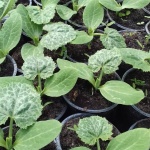

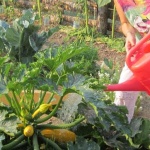
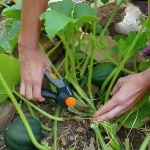
Soil requirements
Well-warmed earth is suitable for planting the Hare's Ear variety. It must be fertile, loose and well-fertilized organic matter. For feeding, complex mixtures are most often used. Top dressing is used during the periods of flowering and ripening of zucchini.
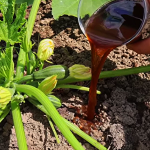
Required climatic conditions
It is worth sowing the Hare's Ear in a well-heated open ground after the threat of morning frost has passed.
Disease and pest resistance
Zucchini Hare's ear - plants that are highly resistant to diseases. However, like most crops, it is affected by fungal diseases such as:
true and downy mildew;
anthracnose;
gray rot.
There are many medications that can help fight fungal diseases. To begin with, you should still use natural remedies, for example, nettle or grapefruit extract. Industrial fungicides perfectly cope with diseases.
The pest that can most often be found when growing a Hare's ear is a spider mite. To destroy it, it is worth using special, proven preparations - insecticides. Their fast action will allow you to keep the harvest on time.
